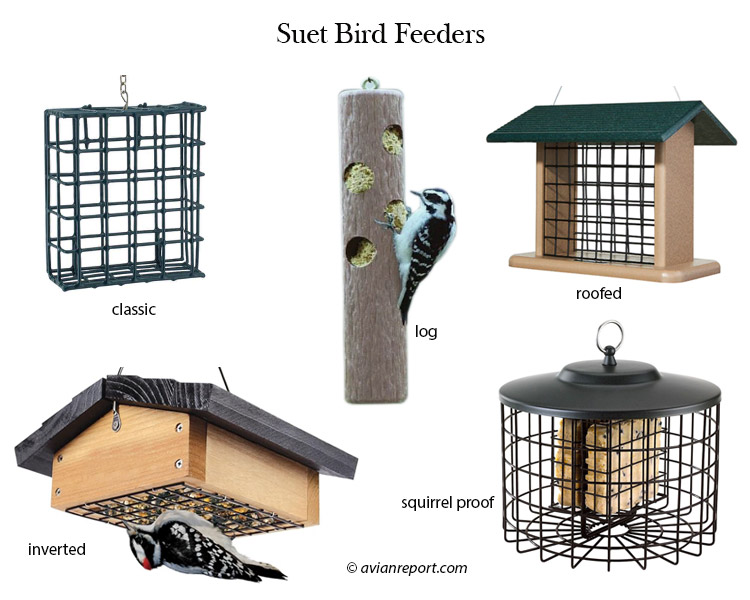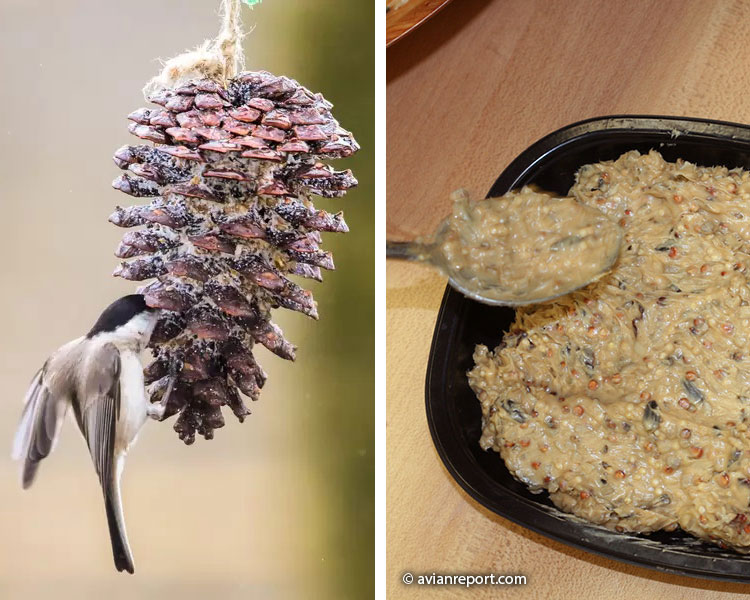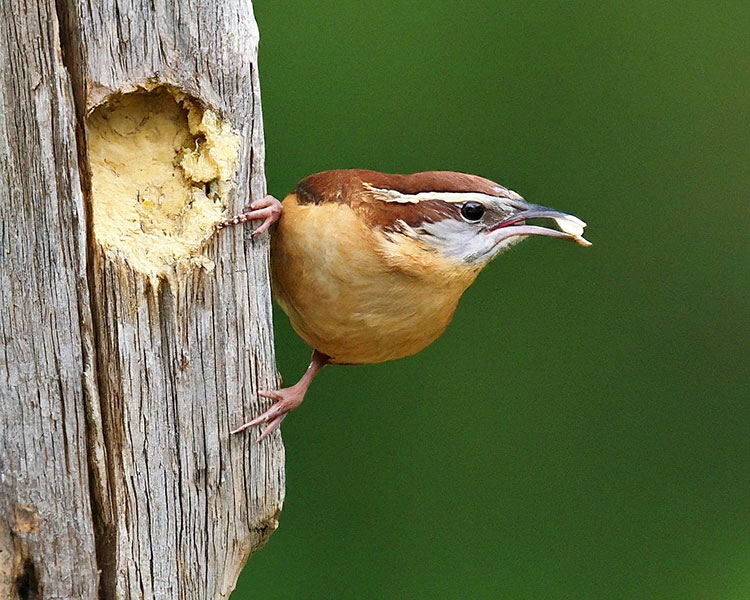Suet bird feeders are a great way to attract a variety of birds to your backyard and provide them with a much-needed energy source during the cold winter months. Chickadees, Nuthatches, Brown Creepers, Wrens, and Woodpeckers love munching on blocks of pressed beef fat (suet) mixed with seeds. Suet feeders may require more frequent monitoring and cleaning compared to seed feeders. Deterring squirrels can be an ongoing challenge.

What is a suet bird feeder?
A suet bird feeder is a specialized feeder designed to offer suet cakes, a favorite food source for many birds, especially during the colder months.
Suet is rendered beef fat mixed with nutritious ingredients like seeds, fruits, or nuts. This provides a valuable source of energy for birds, especially during winter when natural food sources are scarce.
How do birds eat suet: Birds use their beaks to peck at the suet through the cage, breaking off small pieces to eat. The cage design allows for birds of different sizes to access the suet.
Description of the Feeder:
- Material: Suet feeders are commonly made of wood or recycled plastic. Some decorative models may be made of metal.
Design:
- Cage: The core feature is a wire cage that holds the suet cake. The bars or holes in the cage are large enough for birds to access the suet but small enough to deter larger animals like squirrels.
- Perches: Many feeders have perches around the base or integrated into the design to allow birds a place to land comfortably while feeding.
- Removable Tray (Optional): Some feeders have a removable tray below the cage to catch crumbs and make cleaning easier.
Size and Variety: Suet feeders come in a variety of sizes, accommodating different suet cake sizes. They typically range in size from small feeders holding one cake to larger feeders that hold multiple cakes. Some have a sloped roof to protect the suet from the elements.
Related:
Fruit & Jelly Bird Feeders
Hummingbird Nectar Feeders
Window Bird Feeders

Other Types of suet feeders:
- Suet or Peanut Butter Logs: You can buy these pre-made, or make your own by drilling holes in a thick tree branch and filling them with a mixture of suet, peanut butter, and seeds.
- Pinecone: Pinecones work great too. Just pack the crevices with the same suet, peanut butter, and seed mixture.
Refilling Recommendation:
- Suet cakes can melt in hot weather, so monitor feeders regularly and replace cakes when they become depleted or show signs of spoilage.
Birds Attracted:
Suet feeders attract a variety of birds that enjoy a high-energy food source, particularly in winter. Here are some common visitors:
- Woodpeckers: These birds are known for their suet-loving habits and will readily visit feeders.
- Nuthatches: These acrobatic birds can cling to the cage and enjoy the suet.
- Chickadees: These energetic birds will frequent suet feeders for a quick energy boost.
- Wrens: House wrens and Carolina wrens may also visit suet feeders.
- Flickers: These larger woodpeckers can be frequent visitors to suet feeders.
- Jays: Blue jays and Scrub Jays may visit suet feeders, especially if the cage design allows them access.
Related:
Globe Bird Feeders
Thistle Bird Feeders
Hopper or House Bird Feeders

Advantages:
- Attracts a variety of birds that may not visit other feeder types.
- Provides a high-energy food source important for birds, especially in winter.
- Many feeders have features to deter squirrels like cages and small openings.
Disadvantages:
- May attract mess-making birds like woodpeckers who can chip away at the suet.
- Suet can melt in hot weather requiring more frequent monitoring and cleaning.
- Can be difficult to find squirrel-proof feeders as squirrels are persistent in their attempts to access the suet.
- Relatively high maintenance compared to some seed feeders.
Things to Consider:
- Squirrel Deterrence: Squirrels also love suet! Look for feeders with features like smaller cage openings or specially designed baffles to make it more difficult for squirrels to access the suet.
- Summer Heat: Suet can melt in hot weather. You may want to take down suet feeders during the summer months or use feeders with a shaded roof.
- Cleaning: Suet feeders should be cleaned regularly, especially in warm weather, to prevent spoilage and mold growth.
Related:
Tube Bird Feeders
Tray (Platform) Bird Feeder
Key Takeaways about Suet Bird Feeders:
- Winter help to wild birds: Suet feeders offer a high-energy food source (suet cakes) perfect for winter when natural food is scarce.
- The wire cage protection: The cage design allows birds to access the suet in small pieces while deterring larger animals like squirrels. Birds of various sizes can benefit from this design.
- Big help for year-round resident birds: Woodpeckers, nuthatches, chickadees, wrens, flickers, and even some jays are frequent visitors to suet feeders.
- Squirrels can be a problem: Squirrels also love suet! Look for feeders with features like small cage openings or baffles to make it harder for them to access the suet.
- It needs care: Suet can melt in hot weather. Consider removing suet feeders in summer or using feeders with a shaded roof.
- Requires cleaning: Regular cleaning, especially in warm weather, is important to prevent spoilage and mold growth.
Author:
Mr. Begazo, I have a metal suit bird feeder that accommodates 2 suit cakes and prevents squirrels, starlings and grackles from getting to the suit due to the 2′ x 2″ square design openings. The house finches and sparrows went inside to eat the suit when I first hung it but have not been interested in using it all winter. I have washed the metal feeder and re-hung it today, 4/21/2024. The feeder is hanging close to my standard feeder which has black sunflower seeds and is always occupied by the birds. Any idea on what the problem would be regarding the suit feeder?
Hello Stephen,
Good question, I can only guess what maybe happening. One possibility is that those finches and sparrows left the area for the winter?? Other possibility is that birds that usually eat suet, such as woodpeckers, nuthatches, chickadees and titmice may be hesitant to enter/go through the “screen” barrier you have to keep squirrels and starlings from getting to the suet. I am more inclined to think that the latter is more likely.
Let us know if birds return to the suet feeder this Spring and Summer.
Al
Hello~
Do I actually need any kind of roof over the suet feeder..Ease of cleaning is my thoughts…but if a roof covering of any kind is recommended, please provide photo or link of one you recommend…
Thank you
Dora
Hello Dora,
A roof is actually no crucial for a suet feeder. Folks use suet feeders with a roof to protect the Suet from the sun and keep it from melting. Rain does not really affect suet. If a suet bar is keep cool and shady conditions it does not anything to protect it.
Al Begazo